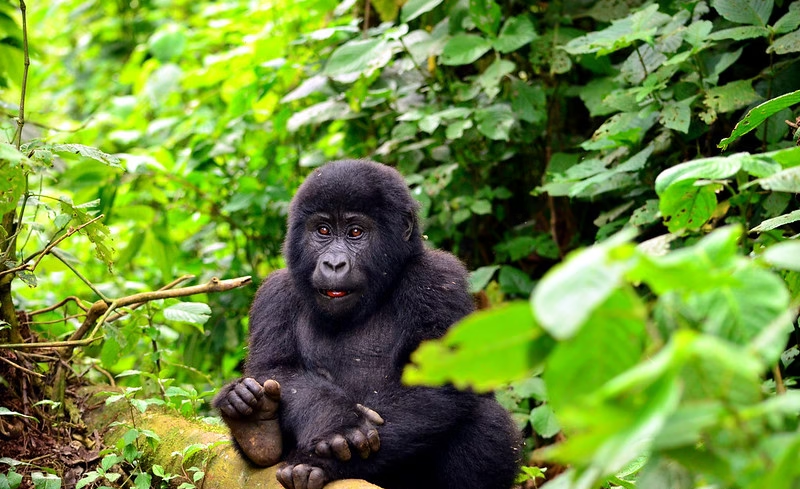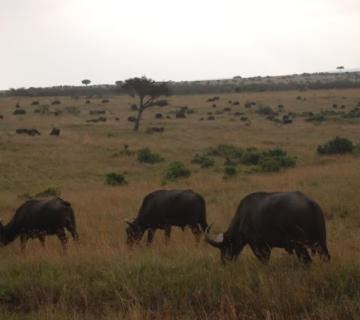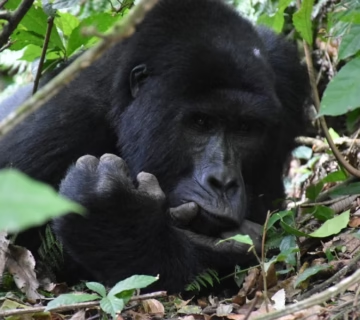Nshongi Gorilla Group In Rushaga
Everything You Need to Know About the Nshongi Gorilla Group in Rushaga The Nshongi Gorilla Group is one of the gorilla groups that live in the Rushaga area of Uganda, which is part of Bwindi Impenetrable National Park. Because it is home to many mountain gorillas, Bwindi Impenetrable National Park is one of the best places in the world to go on a gorilla hiking safari.
There are a lot of people in the Nshongi Gorilla Group, which was once the most settled gorilla group in Bwindi. It was named after the Nshongi River. It’s best to check with park officials or a tour company for the most up-to-date information before making trip plans, since the group’s size can change over time due to births, deaths, and changes in how the group works.
In Bwindi Impenetrable National Park, which includes the Rushaga region home to the Nshongi Group, gorilla hiking is a rare chance to see these amazing animals in their natural environment. It is an exciting way to experience nature and a success story for conservation. Both help to protect these rare species.
The Nshongi are the biggest group of people who live in the Rushaga area of Bwindi Impenetrable National Park. The Nshongi gorilla family lives in the southern part of Bwindi Impenetrable Forest National Park, in the Rushaga area. There is a leader, Silver-back Nshongi, and blackbacks Kakono, Kutu, Tinfayo, Munywa, Bwire, Busasa, Matama, and Bweza. There are also adult females Shida, Bukojo, Nyampundu, and Munini, as well as juveniles Rurehuka, Mureba, Mahoro, and Tindatine and babies Ninsiima, Mukiza, Katoono, Kazani, Rotary, and Bwiruka.
The name of the group comes from the River Nshongi, which runs through the area where they were first seen. This word comes from “Omushongi Gwoboki,” which is the local name for honey. The water in the river is honey-colored, which is how it got its name.
The Nshongi ape family started getting used to people going into their home in 2007. On September 26, 2009, they let guests in, which was a lot of fun. The event, which led to the creation of the “Friend a Gorilla” campaign, was attended by famous people.
GORILLA TREKKING UGANDA IS NSHONGI
Ten of the group’s members broke away under Silverback Mishaya’s direction because of fights within the family. This left the group with only 25 members. The Nshongi gorilla family group split up even more in 2012 when the “Bweza gorilla family” was formed in the Bwindi jungles because of fighting within the group.
The Nshongi Gorilla Group is in Rushaga.
The Nshongi Gorilla Group is in Rushaga.
The number of members in these gorilla families changes over time for many reasons, such as when group members die, when new members join, when long-time members leave, and plenty more.
Gorilla tracking passes in Uganda Park cost as little as $800 USD for foreigners who are not residents there. They cost $700 USD for foreign residents and 300,000 Ugandan Shillings for people who live in the East African Community. You need to book these tracking permits ahead of time with a reputable tour company, like “Maseke Adventure Co.Ltd.”
OTHER GORILLA FAMILIES IN THE RUSHAGA REGION.
When you go after this monkey troop, you can look forward to moments that will last a lifetime. When the Nshongi gorilla family was made available for tracking on September 26, 2009, there were only 35 members left of what had been a huge group.
While the family was together, there were disagreements, and 10 people left the group, leaving only 25 people in Silverback Mishaya’s charge. This group of gorillas gets its name from the River Nshongi, which flows through their home range. The river was a deep shade of what looked like honey.
The name of the ape family, Nshongi, comes from the color of the honey. The name of the river, Omushongi Gwoboki, also comes from this color. The Nshongi gorilla family started getting used to people in 2007 and later opened their home to guests on September 26, 2009. There was a lot of fun and famous people there, which was also the start of the “Friend a Gorilla” program.
The Nshongi gorilla family lives in the southern part of Bwindi Impenetrable Forest National Park, in the Rushaga area. There is a leader, Silver-back Nshongi, and blackbacks Kakono, Kutu, Tinfayo, Munywa, Bwire, Busasa, Matama, and Bweza. There are also adult females Shida, Bukojo, Nyampundu, and Munini, as well as juveniles Rurehuka, Mureba, Mahoro, and Tindatine and babies Ninsiima, Mukiza, Katoono, Kazani, Rotary, and Bwiruka.
There was a new group in the Bwindi woods in 2012 called the “Bweza gorilla family.” This was made because of ongoing fights and other issues that were making some members of the Nshongi gorilla family group uncomfortable.
Please keep in mind that the rules for gorilla hiking and the number of people who can visit a gorilla group can change at any time. Because of this, you must make sure you have the most up-to-date information and all the necessary permissions before you book your journey.
Also, because gorilla trekking is a sensitive activity meant to keep people from disturbing the gorillas and their habitat, it’s very important that you follow all park officials’ and tour guides’ instructions to make sure that everyone has a nice and safe time.
In each part of Bwindi Impenetrable National Park, you can go gorilla hiking with a different group of gorillas. Many gorilla groups live in Rushaga, an area of Bwindi National Park that is famous for them. The Nshongi Group is one of these groups. The Nshongi Gorilla Group may be in a different part of the Rushaga area every day because gorilla groups move around their home ranges in the forest.
Park guards and tour guides will lead hikers to the area where the Nshongi Group currently lives while keeping a close eye on where the group is at all times.
If you want to go gorilla climbing with the Nshongi Gorilla Group in Bwindi Impenetrable National Park, you must get the right permits and work with park officials and trip companies to make sure your experience is respectful and safe. They can also give you the most up-to-date information on where the group is, how to get there, and how to hike.


